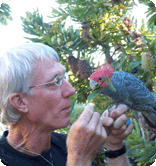Feather Growth in Parrots

Dear EB,
I have a common Indian parrot and unfortunately the seller has clipped its wings. I want to know as to how long it will take for its wings to regrow ie the centre wing span. Daily i take it out of the cage to give it flying lessons but am not sure when it would be able to fly. Presently it flies about 8 to 10 yds only.
Regards
Ranjan Bakshi

Ranjan, Normally an Indian parakeet will moult out its primary wing feathers once a year—if it is in good health. That means the promptness of your parrot growing in new feathers depends upon when they were trimmed by the previous owners. Look for the new flight primaries to begin erupting shortly after you see old large feathers being dropped by the bird. When the new feathers are growing, the shafts will be full of blood, so be careful your parrot does not crash land too hard when it is exercising in its short flights.

































